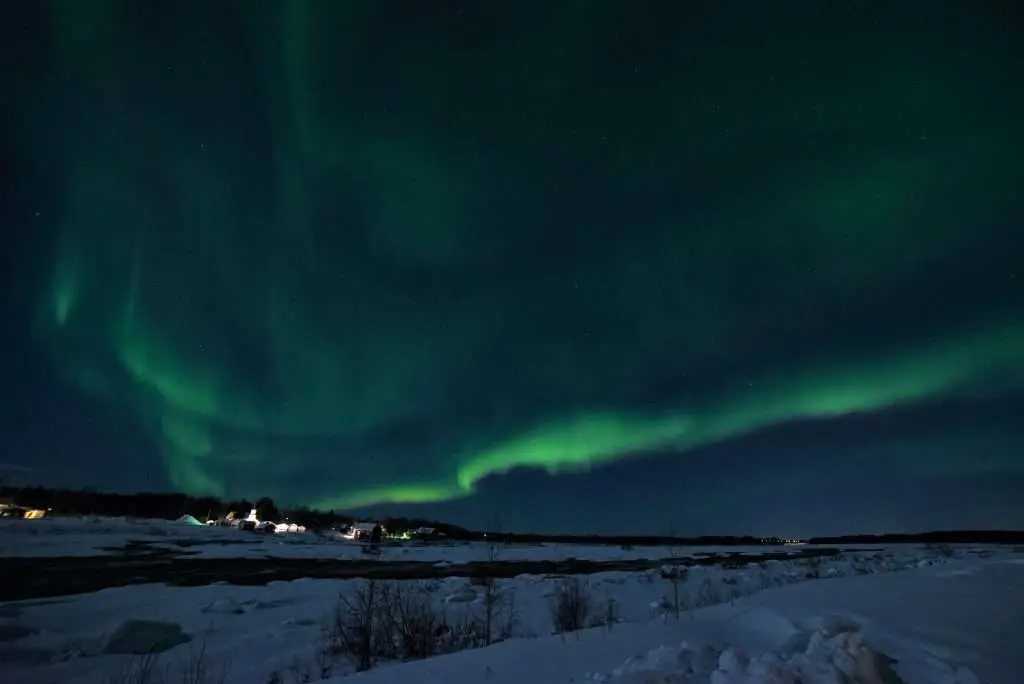How to Photograph the Northern Lights with a Smartphone
Capturing the Northern Lights, or aurora borealis, with a smartphone does present some challenges due to the limitations of smartphone cameras compared to DSLRs or mirrorless cameras. However, with the right techniques and equipment, you can still achieve truly impressive results.

- Upgrade Your Smartphone: Using the Night Mode on a more recent model of the iPhone, such as the recent iPhone 15 Pro Max (or any model from the 11 and up), will help to greatly improve your chances of getting some great shots of the Northern Lights, or any lowlight photo opportunities.
- Use a Tripod: As in most photography, stability is key. Use a solid tripod to ensure that your phone remains steady. Any slight movement can result in blurry images, especially with the longer exposures needed for Northern Lights photography. I’ve used this lightweight tripod from MeFoto for years and it’s always done me right and helped me get great results.
- Smartphone Mount: You’ll also want to have a way to attach your smartphone to your tripod and this one from PICTRON comes highly recommended.
- Remote Shutter Release: Even when using a tripod, tapping the phone to take a picture can cause movement. A remote shutter release (either a physical remote or using your earbuds’ volume button) can help avoid this.
- Wide-Angle Lens Attachment: While some phones now come with built-in wide-angle lenses, if yours doesn’t, consider Investing in an external wide-angle lens attachment such as this one by Moment (just confirm it’s right for your particular phone and that you actually need it). This will allow you to capture a larger portion of the sky.
- Use Manual Mode or a Dedicated App: Many smartphones now come with a manual or pro mode where you can adjust settings like ISO, shutter speed, and focus. If yours doesn’t, download an app like “Filmic Pro” or “ProCam” which offers manual controls.

- Settings:
- ISO: Start with the lowest ISO possible (200 – 400) but you may need to increase it. What this does is make the sensor more sensitive to light but at the same time, it may introduce noise.
- Shutter Speed: Try a shutter speed of around 15-25 seconds. This allows enough light in but might blur very fast-moving auroras, which can actually be a nice effect and something to experiment with.
- Focus: Set your focus to infinity if possible.
- Turn off Flash and HDR: These are not useful for Northern Lights photography and can actually ruin your shots.
- Compose with Foreground Elements: Instead of just shooting the sky, try to include interesting foreground elements, like a silhouette of trees, a mountain range, or a cabin. This adds depth and context to your shots.
- Use the Rule of Thirds: When composing, try to place the Northern Lights along one of the imaginary grid lines (created by dividing your frame into a sort of tic-tac-toe board) to make the scene more balanced and compelling.
- Battery Backup: Cold conditions can drain batteries quickly. Carry a portable charger and/or power bank to ensure you don’t run out of battery at that decisive moment. Also, keep your phone warm by storing it inside your jacket when not in use. You can also use chemical warmers for your hands, feet, and batteries.

Remember that photographing the Northern Lights is as much about patience and persistence as it is about technique. Even with the right equipment and settings, you’ll need Mother Nature to cooperate. So dress warmly, enjoy the experience, and keep experimenting with different settings to get that perfect shot.
Next time I’ll provide tips for shooting the lights with a DSLR or mirrorless camera, which is slightly different, but not quite as different as you might expect.
JOIN US IN LAPLAND
If you’d like to experience the aurora borealis and put your photography skills to the test then join us for Seeking the Northern Lights in Finnish & Swedish Lapland.
This blog post may contain affiliate links for which we get a small commission, but of course, there’s no extra charge to you. These fees help us to continue bringing you great content like this.
The post How to Photograph the Northern Lights with a Smartphone appeared first on Continental DRIFTER.
























